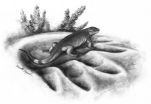(Press-News.org) New research from the University of Toronto Mississauga demonstrates how carnivores transitioned into herbivores for the first time on land.
"The evolution of herbivory was revolutionary to life on land because it meant terrestrial vertebrates could directly access the vast resources provided by terrestrial plants," says paleontologist Robert Reisz, a professor in the Department of Biology. "These herbivores in turn became a major food resource for large land predators."
Previously unknown, the 300-million-year old fossilized juvenile skeleton of Eocasea martini is less than 20 cm long. Found in Kansas, it consists of a partial skull, most of the vertebral column, the pelvis and a hind limb.
By comparing the skeletal anatomy of related animals, Reisz and colleague Jörg Fröbisch of the Museum für Naturkunde and Humboldt-University in Berlin, discovered that Eocasea martini belonged to the caseid branch of the group Synapsid. This group, which includes early terrestrial herbivores and large top predators, ultimately evolved into modern living mammals.
Eocasea lived nearly 80 million years before the age of dinosaurs. "Eocasea is one of the oldest relatives of modern mammals and closes a gap of about 20 million years to the next youngest members of the caseid family," says Fröbisch. "This shows that caseid synapsids were much more ancient than previously documented in the fossil record."
It's also the most primitive member and was carnivorous, feeding on insects and other small animals. Younger members were herbivorous, says Reisz, clear evidence that large terrestrial herbivores evolved from the group's small, non-herbivorous members, such as Eocasea.
"Eocasea is the first animal to start the process that has resulted in a terrestrial ecosystem with many plant eaters supporting fewer and fewer top predators," he says.
Interestingly, Reisz and Fröbisch also found that herbivory, the ability to digest and process high-fibre plant material such as leaves and shoots, was established not just in the lineage that includes Eocasea. It arose independently at least five times, including twice in reptiles.
"When the ability to feed on plants occurred after Eocasea, it seems as though a threshold was passed," says Reisz. "Multiple groups kept re-evolving the same herbivorous traits."
The five groups developed the novel ability to live off plants in staggered bursts with synapsids such as Eocasea preceding reptiles by nearly 30 million years. This shows that herbivory as a feeding strategy evolved first among distant relatives of mammals, instead of ancient reptiles – the branch that eventually gave rise to dinosaurs, birds, and modern reptiles.
The adoption of plant-eating also caused dramatic shifts in the size of early herbivores. When the team mapped the animals on an evolutionary tree, they found that four of the groups showed a tremendous increase in size during the Permian Period, at the end of the Paleozoic Era.
Caseids were the most extreme example of this size increase, says Reisz. The oldest member of the group, Eocasea, was very small, less than 2 kilograms as an adult, while the youngest, last member exceeded 500 kilograms.
Reisz says that the discovery of Eocasea creates questions even as it answers them. "One of the great mysteries to my mind is: why did herbivory not happen before and why did it happen independently in several lineages? That's what's fascinating about this event. It's the first such occurrence, and it resulted in a colossal change in our terrestrial ecosystem."
The research is published online in PLOS ONE.
INFORMATION:
MEDIA CONTACTS
Robert Reisz
Department of Biology
University of Toronto Mississauga
Office: 905-828-3981
robert.reisz@utoronto.ca
Nicolle Wahl
U of T Mississauga Communications
905-569-4656
nicolle.wahl@utoronto.ca
Earliest ancestor of land herbivores discovered
300-million-year-old small predator showed the way to our modern terrestrial ecosystem
2014-04-17
ELSE PRESS RELEASES FROM THIS DATE:
Banning chocolate milk backfires
2014-04-17
ITHACA, N.Y. – To some, banning chocolate milk from elementary schools seemed like a good idea, but new Cornell University research shows that removing chocolate milk from school menus has negative consequences.
"When schools ban chocolate milk, we found it usually backfires. On average, milk sales drop by 10 percent, 29 percent of white milk gets thrown out, and participation in the school lunch program may also decrease," reports Andrew Hanks, lead author and research associate Cornell's Dyson School of Applied Economics and Management. "This is probably not what parents ...
Researchers see hospitalization records as additional tool
2014-04-17
MEDFORD/SOMERVILLE, Mass. – Comparing hospitalization records with data reported to local boards of health presents a more accurate way to monitor how well communities track disease outbreaks, according to a paper published April 16 in the journal PLOS ONE by a research team led by Elena Naumova, Ph.D., professor of civil and environmental engineering and associate dean at Tufts University School of Engineering.
In a paper titled "Hospitalization Records as a Tool for Evaluating Performance of Food and Water-Borne Disease Surveillance Systems: A Massachusetts Case Study," ...
The surprising consequences of banning chocolate milk
2014-04-17
VIDEO:
Director of the Cornell Food and Brand Lab, Brian Wansink recommends, "There are other ways to encourage kids to select white milk without banning the chocolate. Make white milk appear...
Click here for more information.
For many children eating school lunch, chocolate milk is a favorite choice. What would happen if chocolate milk were banned from school cafeterias? "Students take 10% less milk, waste 29% more and may even stop eating school meals," says Andrew Hanks, ...
Family ties in the language jungle
2014-04-17
This news release is available in German. The only linguistic data available for Carabayo, a language spoken by an indigenous group that lives in voluntary isolation, is a set of about 50 words. This list was compiled in 1969 during a brief encounter with one Carabayo family. Frank Seifart of the Max Planck Institute for Evolutionary Anthropology in Leipzig, Germany, and Juan Alvaro Echeverri of the Universidad Nacional de Colombia in Leticia, Colombia, have now analysed this historical data set and compared it with various languages (once) spoken in the region. The ...
High disease load reduces mortality of children
2014-04-17
This news release is available in German. Children who have been conceived during a severe epidemic are more resistant against other pathogens later in life. For the first time this has been proved by researchers at the Max Planck Institute for Demographic Research (MPIDR) in Rostock, Germany, for the 18th century epidemics of measles and smallpox in the Canadian province of Québec. Children who were conceived during the wave of measles in 1714 and 1715 died significantly less often from smallpox 15 years later than children who had been conceived before the measles ...
Declining catch rates in Caribbean green turtle fishery may be result of overfishing
2014-04-17
A 20-year assessment of Nicaragua's legal, artisanal green sea turtle fishery has uncovered a stark reality: greatly reduced overall catch rates of turtles in what may have become an unsustainable take, according to conservation scientists from the Wildlife Conservation Society and University of Florida.
During the research period, conservation scientists estimated that more than 170,000 green turtles were killed between 1991 and 2011, with catch rates peaking in 1997 and 2002 and declining steeply after 2008, likely resulting from over-fishing. The trend in catch rates, ...
In old age, lack of emotion and interest may signal your brain is shrinking
2014-04-16
MINNEAPOLIS – Older people who have apathy but not depression may have smaller brain volumes than those without apathy, according to a new study published in the April 16, 2014, online issue of Neurology®, the medical journal of the American Academy of Neurology. Apathy is a lack of interest or emotion.
"Just as signs of memory loss may signal brain changes related to brain disease, apathy may indicate underlying changes," said Lenore J. Launer, PhD, with the National Institute on Aging at the National Institutes of Health (NIH) in Bethesda, MD, and a member of the American ...
Dermatologists with access to sample drugs write costlier prescriptions, Stanford study finds
2014-04-16
STANFORD, Calif. — Dermatologists with access to free drug samples are more likely than those without access to samples to write prescriptions for drugs that are more expensive, according to a study by researchers at the Stanford University School of Medicine.
Although studies have shown that most physicians do not believe that the availability of free samples affects their behavior or recommendations for patients, the researchers found that the average retail cost of the prescriptions written by dermatologists with access to samples are about twice the cost of prescriptions ...
Free drug samples can change prescribing habits of dermatologists
2014-04-16
The availability of free medication samples in dermatology offices appears to change prescribing practices for acne, a common condition for which free samples are often available.
Free drug samples provided by pharmaceutical companies are widely available in dermatology practices.
The authors investigated prescribing practices for acne vulgaris and rosacea. Data for the study were obtained from a nationally representative sample of dermatologists in the National Disease and Therapeutic Index (NDTI), a survey of office-based U.S. physicians, and from an academic medical ...
Atypical brain connectivity associated with autism spectrum disorder
2014-04-16
Autism spectrum disorder (ASD) in adolescents appears to be associated with atypical connectivity in the brain involving the systems that help people infer what others are thinking and understand the meaning of others' actions and emotions.
The ability to navigate and thrive in complex social systems is commonly impaired in ASD, a neurodevelopmental disorder affecting as many as 1 in 88 children.
The authors used functional magnetic resonance imaging to investigate connectivity in two brain networks involved in social processing: theory of mind (ToM, otherwise known ...
LAST 30 PRESS RELEASES:
Tec-Dara combination offers substantial improvement over standard second-line therapies for relapsed or refractory multiple myeloma
Improving treatment for an autoimmune bleeding condition
Drug reduced need for blood transfusions during hospitalization for non-cardiac surgery
Novel agent ianalumab added to standard therapy extends time to treatment failure in patients with previously treated immune thrombocytopenia
Pirtobrutinib outperforms bendamustine plus rituximab for previously untreated CLL/SLL
Online tracking and privacy on hospital websites
A freely available tool to document wartime destruction
Residential solar panels can raise electricity rates
Scientists use synthetic platelets as ‘Trojan horse’ drug-delivery system
Cooperative Intermolecular Interactions Regulate Supramolecular Polymer Assembly
Korea University researchers develop ultrasensitive method to detect low-frequency cancer mutations
First patient enrolled in GOG-3133/ FRAmework-01 phase 3 study evaluating sofetabart mipitecan (LY4170156), a novel ADC targeting folate receptor alpha (FRα), in recurrent ovarian cancer
Two Hebrew University researchers win prestigious ERC consolidator grants
ERC grant helps to quantify the impact of anthropogenic air pollution particles on climate
Exercise might help improve mobility during aging
New online tool detects drug exposure directly from patient samples
Learn the surprising culprit limiting the abundance of Earth’s largest land animals
Study reveals new ways the brain regulates communication between neurons
Research reveals new hybrid state of matter where solids meet liquids
Researchers develop a new computational tool to understand how genetic interactions impact human traits
Elephants, giraffes and rhinos go where the salt is
Cancer loses its sense of time to avoid stress responses
The twisted nanotubes that tell a story
Flaring black hole whips up ultra-fast winds
Study explores the link between newspaper preference and attitudes towards autism
Artificial turf in the Nordic climate – a question of sustainability
The hidden toll of substance use disorder: annual cost of lost productivity to US economy nearly $93 billion
Among psychologists, AI use is up, but so are concerns
Recycling a pollutant to make ammonia production greener
Common institutional ownership linked to less aggressive business strategies in Chinese firms
[Press-News.org] Earliest ancestor of land herbivores discovered300-million-year-old small predator showed the way to our modern terrestrial ecosystem



